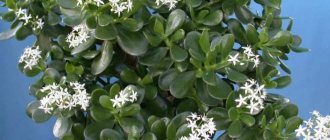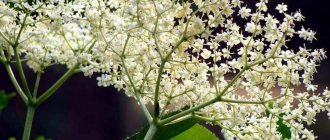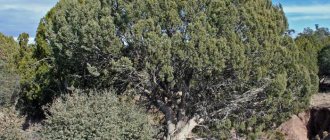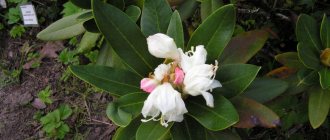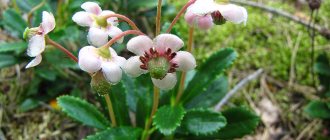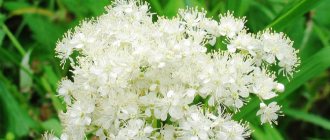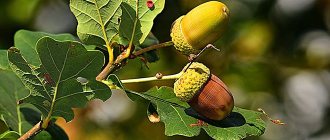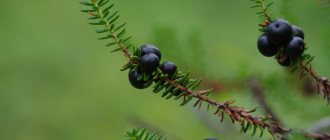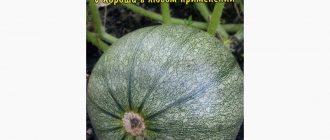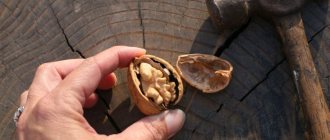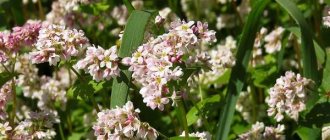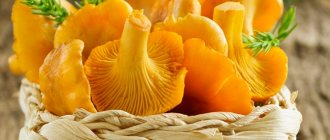What does Eleutherococcus look like in the photo?
See what Eleutherococcus looks like in the photo and use this knowledge for your own purposes...
Eleutherococcus is a plant belonging to the Araliaceae genus, which includes 30 species of thorny trees and shrubs. These plants grow in eastern Asia, in the territory from southeastern Siberia to Japan, and from there to the southern part of the Philippines. The largest variety of Eleutherococcus species can be found in central and western China.
The use of Eleutherococcus in medicine is limited to some species of this plant, mainly Eleutherococcus senticosus, the photo of which you will see below. It is prescribed for low blood pressure, physical and mental fatigue (overwork).
Eleutherococcus
Eleutherococcus is a thorny shrub or tree that belongs to the Araliaceae family. The berry plant is widespread in the southeast of Siberia, as well as in the western and central parts of China. The plant is popularly called “wild pepper”, “free berry”, “devil’s bush”, “Siberian ginseng” and is classified as a garden or medicinal crop. Among the 30 different species, Eleutherococcus senticosus is considered the most famous.
What Eleutherococcus looks like: photo
Some plants of this species are used as ornamental garden shrubs
The well-known drink “Baikal” contains eleutherococcus extract.
And this is what the stems, flowers and fruits of Eleutherococcus look like in the photo
All articles on the site “What does it look like…”
What Eleutherococcus senticosus aesculapius looks like, cultivation, care, reproduction in the country, advice from traditional medicine. Application, extract - Wikipedia.
The Eleutherococcus shrub is found in nature only in certain countries, the climate of which favorably influences its development. The names of the countries can be listed on the fingers - these are Japan, China, Korea and Russia, only here it is distributed in the regions of the very Far East. Well, if you consider Eleutherococcus as a garden plant, then you can easily grow it, don’t even doubt it! The Eleutherococcus bush is not at all picky about soil and shade, so experiment, and we will even help you with this now.
How to properly propagate Eleutherococcus
To propagate Eleutherococcus senticosus, almost all types of propagation are used - vegetative methods, cuttings, layering, and even dividing the bush. Eleutherococcus and its cultivation from seeds are possible in principle, but rather expensive in terms of time and effort. Therefore, we will not consider this option as the best.
Growing in the garden
Looking ahead, I’ll immediately begin to describe how to properly grow a bush using branches and root growth (it can be easily found around the plant). You can separate the offspring from the main bush without any problem, and due to the ability to develop their own small root system, the offspring are easily transplanted and take root. We recommend doing the transplant as always - either in the fall or early spring, when the buds have not yet begun to swell. You should spend the first year after planting with vigilance towards the seedlings, since at a young age they have a very hard time surviving frost and cold, so try to cover them for the winter.
Even before planting begins, you are required to select a site for bushes. Try to completely remove all weeds located in this place and completely dig up the area, approximately 25 cm deep. We add, on average, 6 kg of manure per meter of plot.
We first dig small holes for the seedlings (depth - 50 cm, width - 60 cm). The recommended distance between bushes is 2 meters. After planting an eleutherococcus seedling, it needs to be covered with a fertilized layer of soil (collect it from above), and at the same time increase the planting depth by 3 centimeters. That is, so that the plant is several centimeters deeper than before transplantation. During the next step, we water the ground around the seedling with a very weak solution of potassium permanganate and compact the soil with a shovel.
As I already clarified at first, Eleutherococcus is a shade-loving shrub, so you can choose a planting site even near a huge tree, a walnut, for example. I also recommend planting several bushes in one area, since it may happen that your particular bush will have flowers of only one sex, which will not allow them to be pollinated in the future.
You can see and admire the beautiful flowers only in the 4th year of the bush’s life. There is no need to care for eleutherococcus at all, the only thing is to remove damaged or dried branches from time to time.
Eleutherococcus senticosus, medicinal properties
Almost all parts of this bush are useful and medicinal for the human body. However, just so you know, the most useful thing is the rhizomes and roots of Eleutherococcus senticosus, especially if the bush is more than 6 years old.
In folk medicine, it is allowed and even recommended to take Eleutherococcus senticosus if you want to increase your mental or physical performance. It is even used during wound healing or as a strengthening agent for the body, as a remedy for diabetes and to reduce cholesterol levels in human blood. Believe me, it is better to use traditional medicine than to buy expensive medicines that will worsen your health...
+-
Use in folk medicine
Traditional medicine recommends taking Eleutherococcus in various forms to increase overall tone, performance, and correct visual and hearing acuity. Using the plant increases the likelihood of conception and helps cleanse the body of toxins and poisons.
Chinese medicine uses Eleutherococcus in a wider range. Ancient treatises recommend the plant for kidney diseases, in the early stages of atherosclerosis, and for rheumatic heart disease. It has been observed that the use of an adaptogen accelerates wound healing and promotes speedy recovery after serious illnesses and surgical interventions.
For immunity
Eleutherococcus is one of the first choice remedies if it is necessary to increase the body's resistance to external aggressive influences: infections, toxins, radiation, high and ultra-low temperatures.
Under the influence of eleutherosides, natural enzymes, vitamins and minerals, rapid adaptation to unusual environmental conditions occurs, and internal cell cleansing mechanisms are stimulated.
The effect of Eleutherococcus as a powerful and safe adaptogen has been confirmed by clinical trials. To maintain immune functions, 3 preventive courses per year lasting 30 days are sufficient.
The timing of prophylaxis is selected taking into account personal predisposition to infections or exacerbations of chronic diseases. There is a break of at least a month between courses.
Any form of the drug, pharmacy or home-made, is suitable for treatment and prevention. In the absence of contraindications, an alcohol tincture is chosen as the fastest-acting remedy. For prevention purposes, take 20 drops per day, before meals in the morning.
For the nervous system
By increasing mental and physical performance, Eleutherococcus preparations also create a stable emotional background that weakens the impact of daily or severe traumatic stress. Proper use makes sleep deep and promotes rapid recovery.
Read also Urine therapy - benefit or harm?
With a decrease in anxiety, rehabilitation of addictions, treatment of neuroses and apathy are easier. The ability to remember and process information improves, and the reaction speeds up. A decoction of Eleutherococcus is recommended for use by elderly patients with weakened memory and amnesia.
For diabetes
Eleutherococcus, whose medicinal properties include the ability to reduce the concentration of glucose in the blood, is successfully used in the complex therapy of diabetes mellitus. The use of plant-based products allows you to reduce the dosage of insulin, sulfonamide, and other specific drugs by half. High efficiency is observed in the early stages of the disease.
A general stimulating effect and a persistent decrease in sugar are observed after 14 days of continuous use of eleutherococcus. A single dose has a rapid hypoglycemic effect that does not last longer than 3 hours. The individual dosage of drugs and the form of administration (decoction, extract or tincture) are determined by the attending physician.
For cardiovascular diseases
Under the influence of the active substances in the composition of Eleutherococcus, vasodilation occurs and blood flow to the heart muscle is normalized. The drug can be prescribed by a cardiologist if necessary to compensate for certain disorders of the cardiovascular system, including the treatment of rheumatic carditis.
The early stages of atherosclerosis can be corrected with a course of eleutherococcus due to its ability to control the level of bad cholesterol in the blood. In this way, it is possible to prevent the development of cardiovascular pathologies, especially in old age.
Eleutherococcus, planting and care
The branches have light gray or light brown bark with numerous thin spines directed obliquely downwards. There are fewer thorns on old branches, more on young ones. The leaves are on long petioles, five-palmated, finely serrated, with sparse spines and dense pubescence on the veins.
It blooms in July, the fruits ripen in September. The flowers are small, dioecious and bisexual, on long thin stalks, collected in spherical umbrellas. Female flowers are yellowish, male flowers are pale purple. Flowering plants produce a lot of nectar and attract bees, bumblebees and other insects to pollinate it. The fruit is a drupe, round, five-locular, black.
Eleutherococcus, like ginseng, is a perennial plant and can grow and bear fruit in one place for 50 years or more. Its seeds are characterized by slow germination due to underdevelopment of the embryo.
When planting Eleutherococcus with freshly harvested seeds in autumn, seedlings appear only in the second spring. To obtain seedlings in the first spring when planting Eleutherococcus in autumn or spring, the seeds must be stratified. The stratification technique is the same as for ginseng.
Eleutherococcus reproduces mainly by root and rhizome suckers, as well as green cuttings. For better rooting, green cuttings should be treated with growth stimulants (indolylbutyric acid - 25 mg/l). You can also root lignified annual cuttings (preferably with a heel - a piece of perennial wood 3-5 cm long). To treat the lower part of lignified cuttings, the concentration of the growth stimulator is increased (50 mg/l). One- to two-year-old seedlings or seedlings are planted in a permanent place according to the 2×1 or 3×1.5 scheme, depending on their service life.
Caring for Eleutherococcus involves weeding and loosening, and watering in the absence of rain. Eleutherococcus is not very demanding on soil, but grows better in light shade. It is not yet affected by diseases or pests.
Growing
Agricultural technology
Despite its exotic nature, growing and caring for Eleutherococcus usually does not create problems. In its natural environment, this bush grows in the shade; it is better to find an open place for planting eleutherococcus in the garden. The soil should be neutral, loose, with manure (6 kg per m2).
Layerings are most often used for propagation ; they can be planted both in spring and autumn.
- The holes have a diameter and depth of 0.5 m; when planting a group, the distance between the bushes is 2 m.
- The soil needs to be compacted and watered abundantly.
- The first 2 years require shelter from frost.
It is important to remember that the flowers are unisexual; in order to obtain fruits, it is necessary to plant several plants of different sexes.
If layering is not available, seeds are used for propagation. The process is not complicated, but lengthy.
Hardening of seeds:
- in the fall, seeds placed in damp sand are placed in a room with a temperature of +20°C for 5 months (humidity and air access are important);
- at the next stage, the seeds are placed in the refrigerator for 3 months (temperature + 4 ° C).
At the end of this period, the seeds can be sown in the ground, choosing a slightly shaded place with fertile soil. The bed must be dug up, the roots of weeds must be selected, and furrows 1 cm deep must be made. Not all seeds germinate in the first season. Seedlings from the garden are not transplanted for 3 years.
A full-fledged, flowering plant grows in 4 years.
Caring for Eleutherococcus
Caring for adult bushes is simple:
- Since weeding and loosening are harmful, ground cover plants are planted under the bushes, and lawn grass is sown.
- Watering is required only in dry summers.
- You can (not necessarily) feed the bushes with Kemira (2 tablespoons per bucket of water).
- Eleutherococcus can withstand frosts down to -30°C, so it does not need shelter.
- To prevent the bushes from suffering from bacteria and fungi, sanitary pruning is carried out in early spring. Frozen, dry, broken branches and shoots growing inward are removed. Formative pruning of separately growing bushes is required only if the crowns look unattractive.
- For hedges, formation is carried out annually.
- Young plants can be damaged by frost and rodents. Sheltering is carried out after the soil has frozen (with earlier insulation, the shoots die and fungi develop).
- Areas damaged by rodents are treated with garden varnish in the spring.
- The best time for harvesting roots is October, when the bushes most easily tolerate a decrease in the volume of the root system.
Sources:
https://agronomu.com/bok/5975-eleuterokokk-poleznye-svoystva-rasteniya-ego-vyraschivanie-v-domashnih-usloviyah.html https://flowertimes.ru/eleuterokokk/ https://prorastet.ru/lekarstvennye -travy/lekarstvennye-svojstva-eleuterokokka
Eleutherococcus. Useful properties, application.
Branched bush of the Araliaceae family, up to 2-2.5 m high (sometimes more than 5 m). It has a highly branched root system (up to 30 m long). This is a shrub with black fruits and thorns.
The stem is straight, light gray, covered with thin spines directed obliquely downward. Leaves are long-stalked, palmately compound.
The leaves are eleptic, with a wedge-shaped base, finely serrate along the edges, bare or with bristles above, reddish pubescence below, located along the veins.
The flowers are bisexual, small, pale purple, on long thin stalks, collected in inflorescences in the form of spherical umbrellas at the ends of the branches.
Blooms in July - August. Fruit ripening in September. The fruit is black and shiny. spherical drupe 7-10 mm in diameter. The seeds are yellowish and crescent shaped.
Eleutherococcus grows in mixed forests in the Far East - in the Primorsky and Khabarovsk territories, the Amur region and southern Sakhalin, Korea, Japan, and the northeastern part of China. This plant is grown in botanical gardens.
When the glory of ginseng was booming, teams of root workers were looking for the “root of life” in the taiga and sometimes during the whole summer they found a single root; a ginseng relative, Eleutherococcus, grew nearby, and no one realized that it had similar properties to ginseng. Both Aralia and Eleutherococcus senticosus contain tonic substances, as does ginseng.
In New Zealand, Pseudopanax terribleis is especially famous for its protection. Its columnar leaves easily and freely pierce the forest canopy and, rising above it, spread a mighty crown.
Photo: Thesurvived99
Photo: Sten Porse
Photo: Doronenko
For medicinal purposes, the rhizome with the roots of Eleutherococcus senticosus is used and harvested. Harvesting is carried out in the fall, from the second half of September, by digging or simply pulling out only mature plants above 1 m.
Description
Plant species
Two species are grown in gardens: spiny and sessile-flowered. The first is not only decorative, but also medicinal; the roots have been used in official and alternative medicine for more than 70 years.
- Eleutherococcus senticosus
Eleutherococcus senticosus is often compared in its beneficial properties to ginseng and Rhodiola when it comes to the fight against cancer. In addition to medicinal properties, it has decorative properties.
In its natural environment, it prefers moist soil with a litter of leaves in forests, near rivers, and in the mountains. The height of the bush reaches 3 meters. Yellow shoots covered with thorns without branches.
With age, the color of the branches becomes gray, the number of thorns decreases. People call this plant the devil's bush, wild pepper, and prickly freeberry.
The leaves are compound, on long stalks, of 5 smooth obovate plates, the outer surface is darker than the pubescent back.
It will be interesting to read about Balkan Geranium.
The pedicels are long, very small flowers are light purple, diluted with a yellowish tint, collected in “umbrellas”. Flowering begins in August; oblong, black, shiny fruits ripen by the end of September. The bones in them are large, slightly flattened.
The cylindrical rhizome, located at a depth of 30 cm, is branched. It contains the most vitamins, microelements, fatty acids, and essential oils.
Medicinal properties of Eleutherococcus senticosus:
- stabilization of the nervous system;
- activation of the functions of the musculoskeletal system;
- increased brain activity and performance;
- improved vision, hearing;
- strengthening the immune system;
- increased blood pressure;
- stabilization of sugar levels;
- cell regeneration;
- slowing tumor growth.
Reviews of Eleutherococcus indicate that preparations made from it are effective for the prevention of influenza and other infections during rehabilitation after surgery. Women believe that the tincture improves the condition of the skin, gets rid of rashes, inhibits the development of wrinkles, and improves the condition of the hair.
- Eleutherococcus sessiflora
A bush (rarely a tree) of this species can reach a height of 4 meters, the thorns are of a different shape or are absent. It grows singly or in groups, on hills in the taiga, wooded river banks, and forest edges. Most often the leaves fall in the fall, but evergreen species are found.
Related article: List of garden plants: names and photos
The leaves consist of 3-5 plates, the cuttings are thin, the inflorescences in the form of a brush are located at the ends of the branches. Dark purple, almost brown, sessile flowers, black fruits are ovoid, with 2 seeds inside. Due to its abundant branching, this species is used to create hedges.
A disadvantage can be considered deciduousness, which reduces the decorative effect in the fall. In the United States and Canada, this tree is considered invasive due to its ability to crowd out other plants. When growing, control of root shoots is required.
Application
The prickly species is grown for its medicinal qualities. Eleutherococcus tincture is available in pharmacies, but it can be more profitable to make it yourself.
This makes it possible to use all parts of the plant for treatment. In composition they differ little from the roots.
- For decorative purposes, the bush can be planted on the lawn alone or in a group with other plants; hedges are created from the sessile flowering plant. Both types look beautiful at any time.
- Homemade tinctures are most often prepared from the roots. They are dug up, washed, cut into small pieces, dried in the shade or oven (temperature +50°C with the door open). 100 g is crushed to a powder and poured with 0.5 liters of vodka and placed in a dark place. After 21 days, the tincture must be filtered.
If there is a ban on alcohol or intolerance to it, you can make a tincture with water. Per liter you need 50 g of roots, boil for 15 minutes.
- For the purpose of prevention and improvement of performance, it is taken in the morning. During the course, you should not consume coffee, which enhances the effect of the tincture. For tonics, the roots can be replaced with leaves, including them in dry collections.
- A water tincture is used in the treatment of lesions of the epidermis of the skin (ulcers, abscesses).
- If a sessile-flowering species is grown on the site, medicinal, prophylactic, and cosmetic products are prepared from leaves or bark containing alkaloids. Healthy people take decoctions and tinctures to improve performance.
Products containing Eleutherococcus should not be used:
- if you are allergic to substances contained in the plant;
- children under 12 years of age;
- during pregnancy and lactation;
- for hypertension, tachycardia, arrhythmia;
- for anxiety, stress, insomnia;
- for infectious diseases;
- at elevated temperatures;
- if the gallbladder has been removed.
If a doctor has prescribed pharmaceutical drugs for the treatment of a serious illness, you should not take Eleutherococcus products without consultation.
Eleutherococcus senticosus description, properties, application
The roots are shaken off the soil, washed, chopped into pieces and dried at a temperature of 70-80°C. The rhizome and roots of Eleutherococcus contain phenolic glycosides, which are called eleutherosides, pectin substances, essential oil, resins, gums, flavonoids, and starch.
Beneficial properties of Eleutherococcus
Since Eleutherococcus is similar in its properties to ginseng, it is therefore also called “Siberian ginseng”. Eleutherococcus senticosus has a stimulating effect on the central nervous system, an adaptogenic effect, increases the body's nonspecific resistance, endurance, performance and vitality.
It is used for physical and mental fatigue, for neurasthenia, vegetative neuroses, arrhythmia, for functional hypotension, for the treatment of the initial form of atherosclerosis, for menstrual irregularities, and pathological menopause.
Long-term administration of the extract in therapeutic doses is well tolerated by animals. Eleutherococcus increases the body's resistance to adverse environmental factors, has a stimulating and tonic effect, affects the growth and development of the body, increases animal productivity, and has a gonadotropic effect.
Under the influence of Eleutherococcus, metabolism is normalized, the body's resistance to the harmful effects of various physical, chemical and biological factors is increased, and morbidity is reduced.
It has been established that Eleutherococcus extract significantly increases performance, improves functional indicators of the cardiovascular system, increases the number of red blood cells and hemoglobin in the blood, and improves mineral, carbohydrate and protein metabolism.
Eleutherococcus affects the hypothalamic food center, and in connection with this, the palatability of animal feed increases. It regulates metabolism and promotes economical consumption of carbohydrates.
Eleutherococcus preparations increase vital activity, adaptation to new living conditions, the safety of young poultry, and prevent the adverse effects of environmental factors.
The mechanism of the adaitogenic effect of Eleutherococcus is based on its ability to reduce the manifestations of stress. In this regard, it is used in veterinary treatments and movements of animals. For veterinary treatments of chickens, Eleutherococcus extract can be used in a dose of 0.2 ml for a week before and after treatment. At the same time, the egg production of the bird and its weight gain increase, and feed consumption is reduced. For the same purpose, it is used to prevent transport stress in pigs and normalize animal productivity after illness. Eleutherococcus increases the volume of ejaculate in bulls and the number of sperm in it, and increases the fertility of cows and pigs.
Eleutherococcus preparations promote dilation of peripheral blood vessels, including cerebral and coronary arteries, reduce blood sugar by increasing the permeability of cell membranes to glucose, and are therefore indicated for the treatment of mild forms of diabetes mellitus.
Taking Eleutherococcus preparations after surgery accelerates the restoration of the protein composition of the blood and promotes faster tissue healing. Zleutherococcus relieves symptoms of redness and eye fatigue.
Application in agriculture Currently, Eleutherococcus is used as a growth stimulant in fur farming, reindeer husbandry, and beekeeping. It is recommended to use Eleutherococcus as a means of improving the quality of fur. Animals that received 1 ml/kg of Eleutherococcus root extract for 3 months had a weight of 7.1-8.1% more compared to the control, and the selling price of experimental mink skins was 5.3% higher.
Subcutaneous administration of a prolonged form of Eleutherococcus to pregnant cows at a dose of 50 ml once a month 3 months before calving allowed to increase the safety of calves and reduce the number of cases of dyspepsia. At the same time, there was a decrease in cases of retained placenta, inflammation of the genital tract and organs.
The Eleutherococcus plant is represented by thorny shrubs and trees and is part of the Araliaceae family. This genus includes approximately 30 species. In nature, such a plant can be found from southeastern Siberia to Japan, and further south to the Philippine Islands. The largest number of Eleutherococcus species are found in the western and central regions of China. The most popular among gardeners is Eleutherococcus senticosus, which is an ornamental and medicinal garden shrub.
Chemical composition
Eleutherococcus contains:
- aramin alkaloid;
- flavonoids;
- essential oils;
- coumarin derivatives;
- glucose;
- sugar;
- starch;
- polysaccharides;
- wax;
- resins;
- gum;
- anthocyanins;
- tannins and pectins;
- vegetable fats;
- vitamins (especially vitamin C and carotene);
- microelements;
- eleutherosides A, B, C, D, E.
Features of Eleutherococcus
Eleutherococcus senticosus is also called wild pepper, devil's bush or spiny berry. This deciduous shrub has grayish bark. Its rhizome is highly branched, located in the upper layer of soil, it grows a large number of adventitious roots, their length can reach up to 30 m. The height of such a plant, which has many stems, varies from two to five meters. On the surface of straight shoots there are many thin spines directed downward. The composition of the long-petioled palmate-compound leaf plates includes 5 oval, pointed leaves; they can be bare or slightly bristly on the front side, and on the underside along the veins they are covered with red-colored pile, their edge is sharply double-toothed. The simple umbrella-shaped inflorescences growing at the ends of the stems contain fragrant small flowers with long pedicels: pistillate flowers are pale yellow, and staminate flowers are light purple. The fruits of such a plant cannot be eaten. They are black glossy drupes of a spherical shape, reaching about 10 mm in diameter, inside they have 5 pale yellow bones, the shape of which is similar to a crescent. Their maturation is observed in the first half of autumn; they stay on the branches for a long time. In nature, this species grows in cedar-broad-leaved forests and forms the undergrowth; it can also be found in floodplain spruce forests. Eleutherococcus has been cultivated since 1862.
Growing Eleutherococcus in the garden
Landing rules
Eleutherococcus is a shade-loving plant, characterized by undemanding soil composition. It grows best in moist, nutritious soil in a little shade under a large deciduous tree. When grown in mid-latitudes, such a shrub does not need to be covered for the winter.
Experienced gardeners recommend planting such a shrub in the autumn immediately after the leaf fall ends. If you wish, you can plant it in the spring, but you need to do it before the buds on the trees swell.
Types and varieties of Eleutherococcus with photos and names
Eleutherococcus sessiliflorus
In addition to the Eleutherococcus senticosus described above, gardeners sometimes grow Eleutherococcus sessile flower. The height of this large shrub is about 300 centimeters; on its surface there are imbricated large thorns, which are located relatively sparsely. However, there are also types of eleutherococcus that do not have spines at all. The leaf blades are three to five lobed, their petioles reach about 15 centimeters in length. Dense umbrella-shaped inflorescences consist of small dark brown flowers. The fruit is a glossy black drupe. In nature, this species can be found in Korea, the Far East and China.
Eleutherococcus henryi
Gardeners cultivate this species very rarely. This shrub is characterized by slow growth and frost resistance; it can reach a height of 100–300 cm.
Eleutherococcus simonii
This species can also be found very rarely in gardens. He is originally from Central China. The bush reaches a height of about 5 meters; this species is not adapted to winter in mid-latitude conditions.
Properties of Eleutherococcus: harm and benefit
Medicinal properties of Eleutherococcus
The plant Eleutherococcus is also called “Siberian ginseng”; the fact is that it contains almost all the substances that are contained in the “root of life”. The root of this shrub and its foliage have healing properties. Harvesting of roots is carried out in autumn or spring. In this case, the preparation of leaf plates and their drying is carried out during the flowering period. The main active components of such a plant are considered to be glycosides, and in addition to them, it contains essential oils, gums, resins, polysaccharides and vegetable fats, which are very valuable substances.
This culture is valued for the fact that it helps to increase the stamina and working capacity of the body, improve vision, lower the amount of sugar and cholesterol in the blood, accelerate regeneration processes, restore male strength, relieve physical and mental fatigue, normalize metabolic processes and the activity of the nervous system, relieve pain during menstruation, and it also helps reduce the risk of developing malignant tumors. Products made on the basis of Eleutherococcus are recommended to be taken orally for increased irritability, exhaustion of the nervous system, asthenic syndrome, vegetative-vascular dystonia, arrhythmia, hypotension, the initial stage of diabetes mellitus, cancer, menopause and painful menstruation. Such drugs are also used externally for baldness and oily seborrhea.
Honey from such a plant in combination with its roots has a tonic and stimulating effect. This remedy helps reduce the amount of cholesterol in the blood, increase physical endurance, relieve the effects of stress, protect the body from toxins and infections, strengthen the immune system, normalize metabolic processes, and it is also used to prevent diabetes.
Preparations made from Eleutherococcus are sold in pharmacies in the form of capsules, syrup, dry extract, tablets, dragees, and liquid extract (tincture of Eleutherococcus). As a rule, it is recommended to take tablet forms (dragées, tablets and capsules) no more than four times per day, while liquid preparations, depending on the disease, are drunk in a course of 25 to 30 days, twice or three times a day, 15–50 drops on an empty stomach for half an hour before the meal.
Folk recipes
In alternative medicine, products made from Eleutherococcus are also used, namely: ointment, root decoction and tea:
- Tea . 1 tbsp. Just boiled water is combined with 1 tsp. crushed raw materials. After this, the container must be tightly covered. The drink will be ready after 10–15 minutes. It is recommended to drink it for asthenia, colds, vitamin deficiency, and also to strengthen the body.
- Decoction . 1 liter of water is combined with 50 grams of crushed roots. The mixture is placed on the stove and boiled over low heat for a quarter of an hour. When the mixture has cooled, it is filtered. Drink the infusion ½ tbsp. 3 times a day for vegetative-vascular dystonia, to improve physical and mental activity, as well as to strengthen the body weakened by a long-term illness.
- Ointment for warts . Pork lard, fresh bush roots and garlic cloves (1:1:1) must be chopped using a meat grinder. The mixture is applied in a layer on a gauze bandage and applications are made on the wart, fixing them with a plaster. This procedure is recommended to be done at night.
Contraindications
This plant has one more advantage: it is well absorbed by almost all people. Very rarely, after taking a product made from Eleutherococcus, diarrhea develops. Such drugs are contraindicated for hypertensive patients.
Medicinal properties
With its help you can cure or reduce the manifestations of:
- atherosclerosis, heart and vascular diseases;
- diseases of the nervous system: neuroses, depressive states, hysteria;
- psoriasis, eczema, wounds, rashes and ulcers;
- asthma, bronchitis, pneumonia.
The range of its influence is extremely wide. These are immunomodulatory, protective, tonic, antiseptic properties - in a word, everything that heals and strengthens the body.
Useful qualities of Eleutherococcus:
- has a stimulating and activating effect on the central nervous system and immunity;
- restores the body after prolonged exercise, helps get rid of constant fatigue;
- accelerates metabolic processes in the body;
- increases the body’s overall resistance to diseases, stress, and environmental conditions;
- enhances motor and mental activity;
- accelerates tissue restoration after operations and injuries;
- normalizes blood sugar and cholesterol levels;
- strengthens and normalizes the functions of the reproductive system;
- has antitumor and anti-radiation effect;
- improves appetite;
- relieves apathy and loss of strength;
- adds sharpness to vision and hearing;
- eliminates the causes leading to insomnia.
It also helps when problems arise with appearance.
Cosmetologists include essential oil of Eleutherococcus and extracts from it in creams, lotions, tonics, shampoos, and ointments. However, you can use Eleutherococcus independently. If your hair is normal, you can add eleutherococcus extract to your regular shampoo - this will make it healthy, shiny and beautiful.
This plant is also useful for problems with the scalp, namely oily seborrhea. And adding it to a hair mask, along with burdock oil and red pepper, will help prevent hair loss and dandruff.
Botanical description
The Eleutherococcus bush reaches a height of 2.5 meters and consists of many stems. The bark of the branches of Eleutherococcus senticosus is light brown or light gray.
The root system is located in the top layer of soil. It consists of a highly branched rhizome and numerous adventitious roots. The rhizome is cylindrical, up to 3 cm in diameter, very tough. The bark of the rhizome is brown-yellow, the inside of the rhizome is white, loose, with a specific odor.
Long horizontal underground shoots extend from the rhizome in all directions. From these shoots grow young ground shoots, densely dotted, like the fruiting branches, with thin spines directed towards the base of the shoot.
There are fewer thorns on old branches, more on young ones. If you accidentally grab a bush, you can get a lot of splinters - the thin thorns easily break off when touched. For this property, Eleutherococcus is called the “devil’s bush”.
Beneficial properties of Eleutherococcus
The medicinal properties of eleutherococcus are contained in the roots, which by autumn are filled with healing juices. Eleutherosides are the main active ingredients that head the whole list of beneficial substances contained in the roots of Eleutherococcus.
It has been proven that eleutherococcus is not inferior to ginseng in its therapeutic effect. The juices of the plant stimulate, tone, and have adaptogenic properties.
Attention! Eleutherococcus is contraindicated in case of high blood pressure, patients with high fever, as well as infectious diseases.
The stimulating effect of Eleutherococcus is manifested in a significant increase in the body's performance after a single dose of the drug. With daily use of preparations from Eleutherococcus, their tonic effect is manifested for some time, which is expressed in a long-term increase in performance and good health.
The body's resistance to the action of pathogenic microbes increases , to adverse effects when working in difficult conditions, during cooling, overheating, and so on.
By the way! Eleutherococcus extract is included in the Baikal drink and some other energy drinks.
Tinctures from Eleutherococcus should not be taken during myocardial infarction , during hypertensive crises, during a febrile state, or during exacerbation of inflammation of the pancreas.
Recently, Eleutherococcus leaves, which contain no less biologically active substances, have become widely used for the preparation of tonic medicinal mixtures.
Recipe for “Homemade tincture of Eleutherococcus”: Dried Eleutherococcus root is crushed to a powdery state, poured with vodka in a glass container (0.5 liters of vodka per 100 g of root), tightly closed and placed in a dark place. After 3 weeks, the tincture must be filtered. Take drops once a day before meals for a month. Then you need to take a break for
Dosage form and dosage of use
Eleutherococcus is available in the form of alcohol tincture and tablets.
The tincture consists of eleutherococcus, ethyl alcohol and water. In liquid form, the drug should be taken 15 drops 3 times a day. The additive must be dissolved in a small amount of water. Take eleutherococcus half an hour before meals. The average duration of use is 1 month.
Manufacturers produce Eleutherococcus in capsules and tablets. Such drugs can be recommended for children. These supplements are made without the use of alcohol. 1 capsule contains from 250 to 400 mg of the substance. To improve immunity, you can take 1 tablet per day between meals.
Eleutherococcus extract is sold in pharmacies in 50 ml bottles. Photo source: Internet
Medicinal uses of Eleutherococcus
Eleutherococcus is used in the treatment of low blood pressure and stress. This plant is often used as a prophylactic against viral infections. Eleutherococcus improves lung function. But there is also a minus in this plant - its use increases body weight.
Eleutherococcus is used to improve hearing and visual acuity. In addition, this plant is recommended for the initial stage of atherosclerosis and vegetative-vascular neurosis. Eleutherococcus is used for menstrual irregularities and infertility.
A tincture is prepared from Eleutherococcus, which is indispensable for skin seborrhea. A decoction of the plant is used to rinse damaged hair. A decoction of the roots is recommended for use as a rinse for gum inflammation and stomatitis.
Eleutherococcus tincture. Take 100 grams of plant roots, pour in two glasses of vodka and leave for 14 days, shaking occasionally. After this, filter the tincture and take drops three times a day before meals. It is used externally for skin masks, rubdowns and lotions.
Eleutherococcus tea. To prepare it, you need to take the roots of the plant and pour a glass of boiling water. Let stand covered for 10 minutes. When the infusion has cooled, drink it instead of plain tea three times a day. Tea tones the body and calms the nervous system.
A course of treatment with such a plant will help the human body quickly cope with increased physical activity and various climatic changes. Eleutherococcus activates the immune system, increases sexual potential, and restores hearing after adverse noise exposure. Various preparations containing such an excellent plant are often prescribed for disorders of the nervous system, depression and neuroses.
The positive effect of Eleutherococcus on heart function is observed in older people. Taking a special drug containing Eleutherococcus in a dosage of 30 drops for two weeks, provided that it is consumed 3 times a day, leads to the appearance of vigor, a significant improvement in well-being, as well as increased performance and improved sleep. As an excellent tonic, modern doctors recommend taking this medicine during periods of mass epidemics and in the cold season.
An infusion of Eleutherococcus leaves has excellent wound-healing properties, which makes it widely used for the treatment of abscesses, ulcers and other damage to the epidermis. For amnesia, you can prepare a healing remedy based on 50 grams of roots and 1 liter of water. This mixture should be boiled for 15 minutes. This decoction of eleutherococcus is taken warm, no more than four glasses per day. If necessary, it can be sweetened with honey.
Eleutherococcus for hair. For seborrhea, baldness and brittle hair, effective treatment is prescribed with special preparations from Eleutherococcus. They have a positive effect on the general condition of the scalp, normalizing lipid metabolism. To significantly reduce the process of hair loss, it is recommended to rub various products into the skin before each wash. Along with this, modern trichologists recommend taking the miraculous extract of Eleutherococcus orally. The course of treatment should be at least one month, starting with 5 drops and ending with 40 drops per glass of water. This medicine must be taken 3 times a day.
You can also use various decoctions to rinse your hair . To prepare this product, take no more than 500 ml of water for 10 grams of eleutherococcus roots and 5 grams of calendula flowers. Boil the mixture for 10 minutes, cool and carefully strain. Using this decoction 2 times a week will be sufficient to strengthen the hair follicles.
Eleutherococcus for immunity. Eleutherococcus is rightfully considered one of the most powerful adaptogens. Extract and other preparations from this plant help to adapt much faster and easier to various unfavorable environmental factors. After serious illnesses of increased severity, such a herbaceous plant is simply irreplaceable. As a rule, Eleutherococcus is indicated after chronic pulmonary diseases, pneumonia, and it also perfectly restores the immune system in cases of serious vibration diseases.
With such an ailment as thymomegaly, the presented plant is included in the general complex of powerful preoperative preparation, due to the fact that it is an excellent preventive agent for immunosuppression and the necessary correction of metabolic disorders. This reduces the risk of recurrent and new diseases by at least two times. It should be noted that the unique adaptogenic properties of Eleutherococcus are widely used at the stages of radiation, chemotherapy and surgical care for all cancer patients. Treatment with Eleutherococcus also gives results in combination with modern antibiotics not only for radiation sickness, but also for cancer.
Eleutherococcus - contraindications and harm
The benefits and medicinal properties of eleutherococcus are numerous, but, unfortunately, there are also a number of contraindications that you need to become familiar with.
The effect of taking a product based on eleutherococcus occurs in the first hour and lasts for several hours.
Contraindications to taking Eleutherococcus:
- allergies, individual intolerance;
- increased excitability;
- insomnia;
- high blood pressure;
- atherosclerosis;
- acute heart failure;
- acute infectious diseases;
- myocardial infarction;
- arrhythmias;
- cerebrovascular pathology;
- exacerbation of any disease;
- pregnancy and lactation;
- age up to 12 years.
Read also Calendula - beneficial properties, application, recipes and treatment with calendula
If you have sleep disorders, you should not take Eleutherococcus in the afternoon.
The use of products that contain electerococcus can cause:
- allergic reactions;
- irritability, anxiety;
- insomnia;
- hypoglycemia;
- diarrhea.
When taking Eleutherococcus, it should be taken into account that the drug enhances the effect of central nervous system stimulants and is an antagonist of drugs that depress the central nervous system (also barbiturates, anxiolytics and antiepileptic drugs).
Reproduction
Eleutherococcus reproduces by seeds, layering and suckers, lignified and green cuttings, and dividing the bush.
Eleutherococcus seeds germinate slowly due to the underdevelopment of the embryo at the time of ripening. Therefore, fresh seeds sown in the same fall sprout in the second or third spring.
Eleutherococcus is best propagated by root suckers , many of which appear near the mother plants. They can be replanted to a permanent place either in early spring before buds open, or in autumn after the wood has matured. They are easily separated from the mother bush, have good root lobes and take root well.
Like black currants, Eleutherococcus can be propagated by horizontal layering . In early spring, you need to dig 15 cm deep grooves near the bush in the right direction, bend the branches to the ground, pin them with wooden hooks, cover them with loose fertile soil and systematically water them. By autumn, the rooted cuttings are cut off from the mother bush and planted in a permanent place or for growing.
When propagating from lignified annual cuttings, the lower ends of the cuttings must first be treated with a solution of the growth substance.
Propagation by green cuttings is very troublesome and is usually not used in amateur gardens.
Where and how to plant Eleutherococcus
When planting young Eleutherococcus plants in the garden, you must always remember that in the wild they are plants of the lower tier of the forest. Therefore, it should be placed only under the protection of sparse tree stands.
Eleutherococcus can grow on any soil except acidic, but prefers light loams rich in humus.
The seedlings are planted in a permanent place in planting holes measuring 60×60×60 cm and with a distance between them. The holes are filled with the top layer of soil, adding buckets of rotted manure or compost, half a glass of nitrophoska, glasses of ash, at least 1 bucket of river sand and the same amount of peat .
Eleutherococcus seedlings are planted deeper than they grew before transplantation. Then the plants are watered abundantly, and the soil is mulched with fallen leaves or peat.
